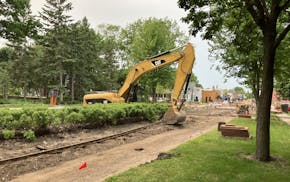Minneapolis Public Schools is asking voters to back a $20 million a year levy increase for technology this fall, but that's just part of the story.
The cash-strapped district is trying to find a sustainable path forward after digging deep into reserves, and as its costs and class sizes rise, hard fiscal decisions remain.
Merge programs? Close schools? Expand dual-language offerings? A recently released timeline of the district's so-called "transformation process" suggests that action won't be coming soon.
For now, voters will decide in November on the $20 million a year increase — a move the district says would free up spending on general operations and minimize cuts to other programs and services.
"I don't know of any school board or school district that prefers property taxes as the mechanism to fund our schools, but it is where we are at," said Ryan Strack, who serves as assistant to the school board and Superintendent Lisa Sayles-Adams.
The ballot measure would allow the district to replace an $18 million a year capital project levy with a new $38 million a year levy to run for 10 years, beginning in 2025.
General-fund dollars would be freed up in the 2025-26 school year because the district's current $33 million technology budget requires it to pull money that typically would go to classroom operations and other general expenditures, and use it instead to help finance equipment upgrades, software licenses, cybersecurity and IT infrastructure maintenance and upgrades.
The district says taxes on a $350,000 house would rise by $8 a month, or $96 a year, if the request is approved.
At the Aug. 6 meeting during which the board agreed to put the proposal on the ballot, Marcia Howard, president of the teacher chapter of the Minneapolis Federation of Teachers, sounded a cautionary note to board members: "Some people right now are saying: '$8 a household, we can't even afford that right now.'"
Howard also drew a connection to the broader district transformation discussions, saying people were prepared to partner with the board if it governed with a strong hand.
"Trust is gonna be essential," she said. "We need to trust y'all are going to boss up."
But the board and district administrators have taken their time moving on the more sweeping transformation plan.
More questions ahead for the district
The resolution initiating the transformation process, which could include merging, closing or expanding schools, was approved in December, but work shifted to erasing a $100 million-plus budget deficit for 2024-25.
Talk of transformation picked up anew last week with a top administrator outlining plans for board members and others to conduct walkthroughs of buildings beginning Oct. 9.
The physical space study also will include reviews of walk zones and enrollment numbers, plus how special education services are delivered, said Tom Parent, the district's senior operations officer.
"I think the process will get us to a deeper level of understanding," he said. "We're certainly not coming in with nothing. But I'm excited to begin to deepen and layer into that information."
But the size of the potential budget gap heading into 2025-26 is perhaps the biggest question, and answers most likely will not be known in full until December, officials say.
Ibrahima Diop, the district's senior officer of finance, said the district is awaiting the final audit of 2023-24 expenditures and the rainy-day fund that remains, plus the amount of revenue it will receive based on Oct. 1 student counts and the various levy proposals.
Then, he said, the school board must move to close the gap in January and February. It is hoped, Diop added, that the deficit won't be as "huge" as in recent years.
"Rarely has it been the case that our revenues surpassed our expenditures," he said.
As for the $20 million a year technology levy hike, early voting now is underway.
Correction: This story has been update to correct the year when general-fund dollars would be freed up.

On the campaign trail, Elon Musk juggled drugs and family drama
In South Carolina, Walz says Democrats 'need to change the attitude'

Grand Avenue reconstruction unearths streetcar tracks, showing St. Paul's past

What we know about state workers' return to office next week

